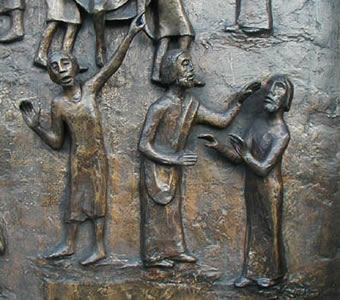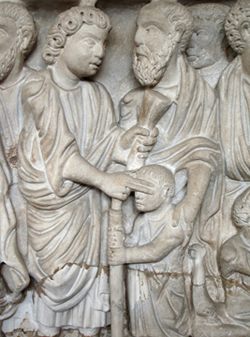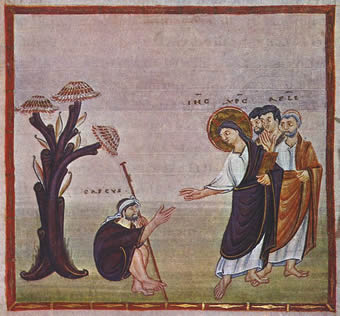"Jesus Spit"
Fourth Sunday in Lent
For Sunday April 3, 2011
Lectionary Readings (Revised Common Lectionary, Year A)
1 Samuel 16:1–13
Psalm 23
Ephesians 5:8–14
John 9:1–41
The gospel this week concludes with a punch line that is both enigmatic and disturbing: "For judgment I have come into this world, so that the blind will see and those who see will become blind." When some Pharisees asked if they were blind, Jesus responded, "If you were blind, you would not be guilty of sin; but now that you claim you can see, your guilt remains" (John 9:39-41).
Blindness is bad enough, but with blindness there's always hope for healing. The claim to see can be far worse, for it masks a blindness to the need for corrective vision.
 |
Detail of ceremonial bronze door, St. James Cathedral, Seattle, by Ulrich Henn. |
In the Christian scheme of things, one of the most dangerous spiritual places we can live is in the deluded notion that we are a fully-sighted person. Conversely, the healthiest place to live is not only to acknowledge our spiritual blindness, but also to recognize that as a good place to live. In acknowledging our blindness, we live in the light; by believing that we see fully and rightly, we stumble in the darkness.
John 9:1–41 recounts the healing of a beggar who was blind from birth. The details of the miracle itself comprise only about one third of the narrative. Most of the story revolves around the disputes that the miracle provoked, followed by Jesus's punch line. So many fascinating details merit attention: earthy descriptions about spit, mud, and the interrogation of parents that characterize an eyewitness account; the casual disinterest and ignorance about Jesus on the part of the man who received the miracle; the inexcusably cruel insinuation by the disciples that somehow human misfortune (the beggar's blindness) was an act of divine punishment; the inherent skepticism and suspicion surrounding the plausibility of a genuine miracle (so much for the ancient's gullibility about miracles); the complex factors at play that can prevent a miracle from evincing genuine faith; and the interactions among the characters in the larger drama — Jesus, his disciples, the blind beggar, his parents, the religious elite, and even the neighborhood community.
 |
Healing of the man born blind, Germany, c. 980-993. |
The professional clergy made all the wrong moves in this story. As in many Jesus stories, in this one religion harms instead of heals. The clergy refused to believe eye-witness accounts of the miracle. They were more concerned to maintain ritual righteousness about Sabbath-keeping than to love a fellow human being and rejoice in his wholeness. They blabbered pious cliches. They scapegoated the victim and "hurled insults" at him. They condescendingly claimed a spiritual elitism that intentionally humiliated the beggar. They demonized him as a "sinner." As they threw him out of the synagogue their rage exploded, "How dare you lecture us!" With that, their own tragic blindness was confirmed, and the story flips — it was the spiritual blindness of the Pharisees, not the physical blindness of the beggar, that forms the crux of the story.
Acknowledging your own spiritual blindness can be embarrassing, painful, and threatening. To confess your own groping darkness and howling demons, your frustrations, fears, and failures, unnerves us. And as unsettling as that confession is to make to your own self, there is the added anxiety of what others might say, think, or do. We know from experience, and from the disciples and the clerics in this gospel story, just how cruel and condescending, how derogatory and dismissive, people can be towards the blind. Some people will kick you when you are down. We shoot the wounded.
 |
Healing of the man born blind, detail of 4th century sarcophagus. |
Healthy people befriend their blindness and make their peace with it. That's different than self-pity, self-loathing, rationalizing it, or invoking it as an excuse. Spiritually-sighted people recognize that acknowledging their blindness is an act of liberation not a confession of bondage. Perfection is an awful and oppressive burden to bear. Only when we identify our symptoms can we experience a cure. The journey toward the light begins when we acknowledge our darkness.
In the epistle for this week, Paul urges the Ephesians to "live in the light" and repudiate the "deeds of darkness." But to see ourselves and the world like God does requires radical vision correction. That's because God doesn't look at the world like we do. Samuel anointed David as Israel's new king only after looking at David's seven brawny brothers and hearing God dismiss them: "The Lord does not look at the things that man looks at. Man looks at the outward appearance, but the Lord looks at the heart" (1 Samuel 16:7). David was the youngest and most unlikely political candidate, but God had chosen him, and so "from that day on the Spirit of the Lord came upon David in power" (16:13).
In her essay on the transfiguration of Jesus, Amy Frykholm considers our own transfiguration. She observes how difficult it is to see the world and ourselves like God does. Old habits die hard. Our field of vision is habituated by past choices. Frykholm draws on Annie Dillard’s essay “Seeing,” in which Dillard describes a person born blind whose sight was restored through surgery — a healing not unlike this week's gospel. But seeing the world with new vision was far harder than you might think.
 |
Healing the blind man of Jericho, Germany, c. 980-993
. |
Frykholm writes: "The person had to reconcile preconceived notions of the world with objects, colors and distances. Much of what she saw simply felt wrong. A newly sighted person can easily get the meanings wrong, even though she has a radical new gift. This suggests a spiritual kind of sight as well as a physical — that a person having received a radical new gift might struggle to understand precisely how to use it."1
Jesus calls himself "the light of the world" (John 9:5). In his prologue John uses this image of light seven times. Jesus enlightens the world's darkness and heals our blindness. But in so doing he is also the Great Divider (John 7:43, 9:16, 10:19). "For judgment I have come into this world, so that the blind will see and those who see will become blind. If you were blind, you would not be guilty of sin; but now that you claim you can see, your guilt remains." Acknowledging our darkness is good and necessary, but longing for the light carries its own unique risks and rewards.
[1] Amy Frykholm, JourneyWithJesus.net essay of March 6, 2011.
For further reflection:
* What connections can you make between physical and spiritual blindness?
* Who do you identify with in the story of John 9?
* Yehuda Amichai, The Place Where We Are Right:
From the place where we are right
Flowers will never grow
In the spring.
The place where we are right
Is hard and trampled
Like a yard.
But doubts and loves
Dig up the world
Like a mole, a plow.
And a whisper will be heard in the place
Where the ruined
House once stood.
From http://en.wikipedia.org/wiki/Yehuda_Amichai: Yehuda Amichai (May 3, 1924 – September 22, 2000) was an Israeli poet. Amichai is considered by many, both in Israel and internationally, as Israel's greatest modern poet.
Image credits: (1) St. James Cathedral, Seattle, USA; (2) Wikimedia.org; (3) cleansingfiredor.com; and (4) Wikimedia.org.





